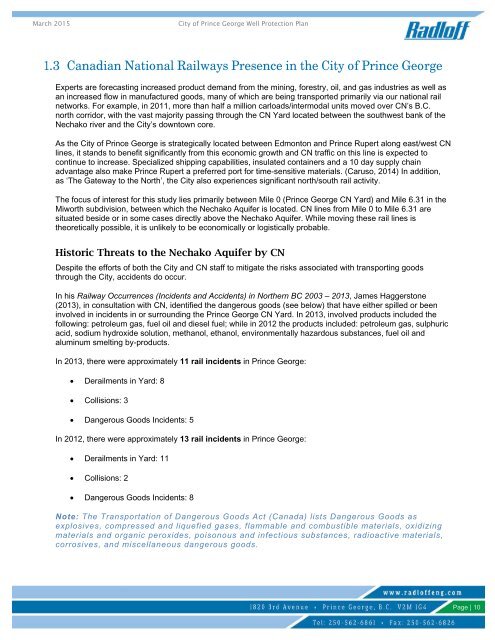CITY OF PRINCE GEORGE WELLS PROTECTION PLAN
Attch_February%2026%202016%20CPG%20wells%20protection%20report%20FINAL%20DRAFT%20V3
Attch_February%2026%202016%20CPG%20wells%20protection%20report%20FINAL%20DRAFT%20V3
You also want an ePaper? Increase the reach of your titles
YUMPU automatically turns print PDFs into web optimized ePapers that Google loves.
March 2015<br />
City of Prince George Well Protection Plan<br />
1.3 Canadian National Railways Presence in the City of Prince George<br />
Experts are forecasting increased product demand from the mining, forestry, oil, and gas industries as well as<br />
an increased flow in manufactured goods, many of which are being transported primarily via our national rail<br />
networks. For example, in 2011, more than half a million carloads/intermodal units moved over CN’s B.C.<br />
north corridor, with the vast majority passing through the CN Yard located between the southwest bank of the<br />
Nechako river and the City’s downtown core.<br />
As the City of Prince George is strategically located between Edmonton and Prince Rupert along east/west CN<br />
lines, it stands to benefit significantly from this economic growth and CN traffic on this line is expected to<br />
continue to increase. Specialized shipping capabilities, insulated containers and a 10 day supply chain<br />
advantage also make Prince Rupert a preferred port for time-sensitive materials. (Caruso, 2014) In addition,<br />
as ‘The Gateway to the North’, the City also experiences significant north/south rail activity.<br />
The focus of interest for this study lies primarily between Mile 0 (Prince George CN Yard) and Mile 6.31 in the<br />
Miworth subdivision, between which the Nechako Aquifer is located. CN lines from Mile 0 to Mile 6.31 are<br />
situated beside or in some cases directly above the Nechako Aquifer. While moving these rail lines is<br />
theoretically possible, it is unlikely to be economically or logistically probable.<br />
Historic Threats to the Nechako Aquifer by CN<br />
Despite the efforts of both the City and CN staff to mitigate the risks associated with transporting goods<br />
through the City, accidents do occur.<br />
In his Railway Occurrences (Incidents and Accidents) in Northern BC 2003 – 2013, James Haggerstone<br />
(2013), in consultation with CN, identified the dangerous goods (see below) that have either spilled or been<br />
involved in incidents in or surrounding the Prince George CN Yard. In 2013, involved products included the<br />
following: petroleum gas, fuel oil and diesel fuel; while in 2012 the products included: petroleum gas, sulphuric<br />
acid, sodium hydroxide solution, methanol, ethanol, environmentally hazardous substances, fuel oil and<br />
aluminum smelting by-products.<br />
In 2013, there were approximately 11 rail incidents in Prince George:<br />
Derailments in Yard: 8<br />
Collisions: 3<br />
Dangerous Goods Incidents: 5<br />
In 2012, there were approximately 13 rail incidents in Prince George:<br />
Derailments in Yard: 11<br />
Collisions: 2<br />
Dangerous Goods Incidents: 8<br />
Note: The Transportation of Dangerous Goods Act (Canada) lists Dangerous Goods as<br />
explosives, compressed and liquefied gases, flammable and combustible materials, oxidizing<br />
materials and organic peroxides, poisonous and infectious substances, radioactive materials,<br />
corrosives, and miscellaneous dangerous goods.<br />
Page | 10


